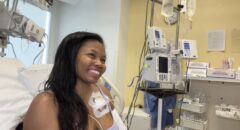
In 2018, Dr. Dawn Nelson took the stage as the keynote speaker at the annual Charles F. Whitten Memorial Lecture to address a packed crowd about the prevalence of dizziness, falling and hearing loss in people living with sickle cell anemia.
While there have been many discussions and resources provided detailing pain symptoms associated with sickle cell anemia, dizziness, hearing loss and falling are topics that have been overlooked within the sickle cell discussion.
Bone and muscle pain are common when a patient experiences a sickle cell crisis because blood vessels in these tissues are very small, leading to an increase in the disruption of regular blood flow due to the sickle shape of red blood cells.
The cochlear-vestibular system, or your hearing and balance system located in the inner ear, are no different. This network of neural tissues, bones, and fluids is smaller than the size of a golf ball but has a disproportionately high blood supply for its size.
There is an intricate and vast network of small arteries that are responsible for providing oxygenated blood to the inner ear and because of the diameter of these vessels, premature red blood cells with a sickled shape are more likely to become clogged decreasing the volume of blood flow.
Dr. Nelson conducted a systematic review of the literature on sickle cell and associated hearing loss to find that anywhere from 21-66 percent (average 37 percent) of people living with sickle cell also suffer from some level of hearing loss of difficulty at some point. Further investigation revealed that the majority of patients reported that hearing loss fluctuated and had a close association to flare-ups of sickle cell crisis.
RELATED: 8 Ways To Live Your Best Life With Sickle Cell
Because the inner ear is home to both our hearing and balance systems, they are directly related in terms of function and volume of blood flow. Not surprisingly, up to 67 percent of patients with sickle cell disease report experiencing dizziness and imbalance in and out of a crisis.
Also closely associated with the volume of blood flow to the inner ear, dizziness, and hearing is the prevalence of falls within the sickle cell community. It is estimated that 20 percent of adults over the age of 65 fall annually, according to Dr. Nelson younger adults suffering from sickle cell anemia fall at a rate even higher than those over the age of 65.
However, sickle cell is not the only process or disorder that can affect balance and falls. It is important to note that blindness, numbness of the feet and ankles, hip, knee or ankle surgery/replacements and stroke may all affect balance and rate of falls independent of sickle cell anemia.
The most common causes of damage to the inner ear, home to the hearing and balance systems, include a lack of oxygen due to the decreased carrying capacity of sickled red blood cells. The sickling of the cells can lead to “sludging” of blood in the inner ear, increasing inner ear damage. Damage to inner ear structures such as labyrinthine ossification or hemorrhage and even ischemia of the Organ of Corti are also complications associated with sickle cell anemia.
Sickle cell anemia is a condition that can be managed through several lifestyle modifications. Supplementation with folic acid and maintaining a high water intake have been linked to a reduction in sickle cell crises. Avoiding extreme temperatures, doing regular exercise and the use of some over-the-counter medications can also help manage sickle cell anemia.

Dr. Kevin Kinney, board certified and licensed Chiropractic Physician featured on INSIDER.com, TheTodayShow.com & BlackDoctorsMatter.org. Connect with Dr. Kev at drkevinkinney.com or @DrDuval904









